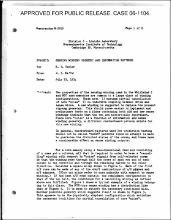Sensing Winding Geometry and Information Patterns
Raffel, J. I.

DownloadMC665_r13_M-2919.pdf (1.237Mb)
Date
1954-07-22Abstract
Two properties of the sensing winding used in the Whirlwind I and MTC core memories are common to a large class of winding configurations. These are: 1) maximum partial cancellation of core "noise" 2) no inductive coupling between drive and sense wires. A new winding is suggested to replace the present zig-zag geometry. This should prove easier to implement and preliminary tests on a plane containing both old and new sense windings indicate that the two are electrically equivalent. Since core "noise" is a function of information and sense winding geometry, a different checkerboard pattern exists for this new winding.
In general, checkerboard patterns for production testing should not be called "worst" patterns since no attempt is made to guarantee the disturb states of the cores, and these have a considerable effect on sense winding outputs.